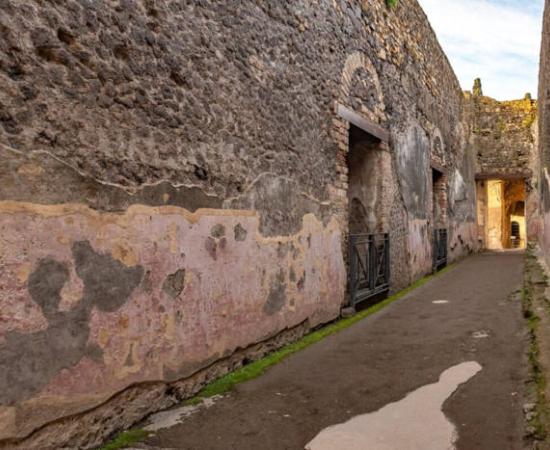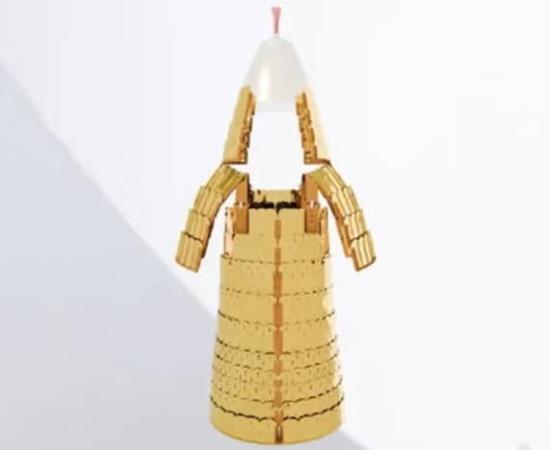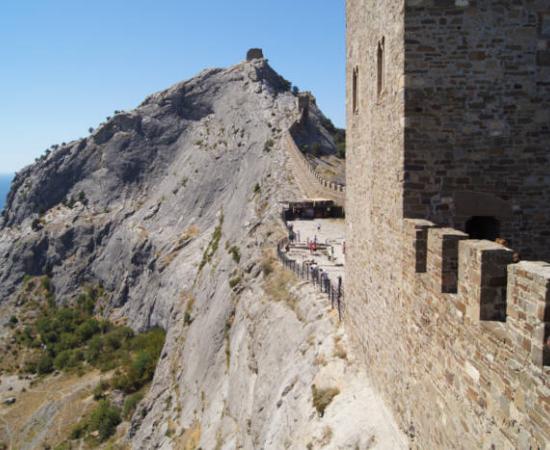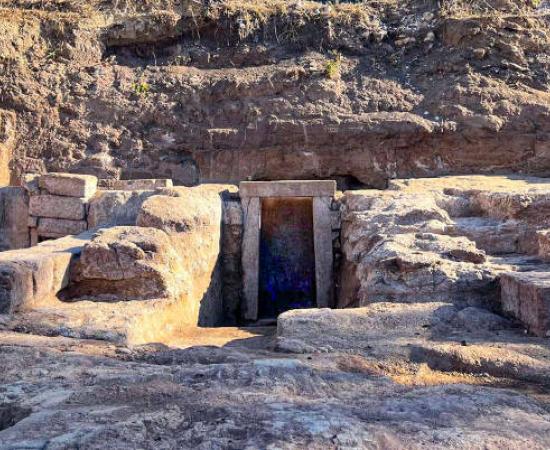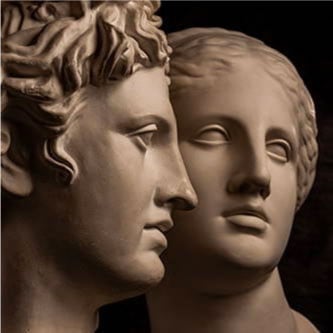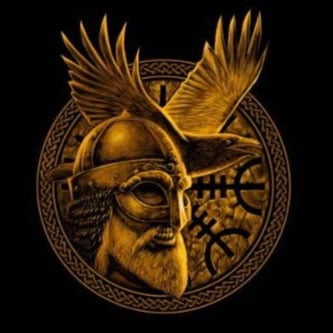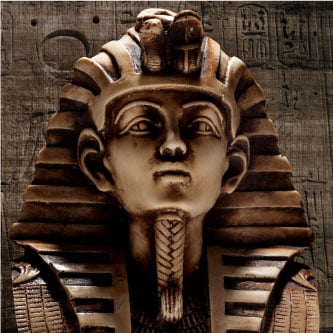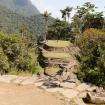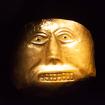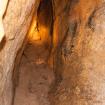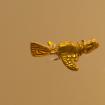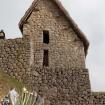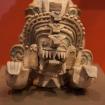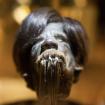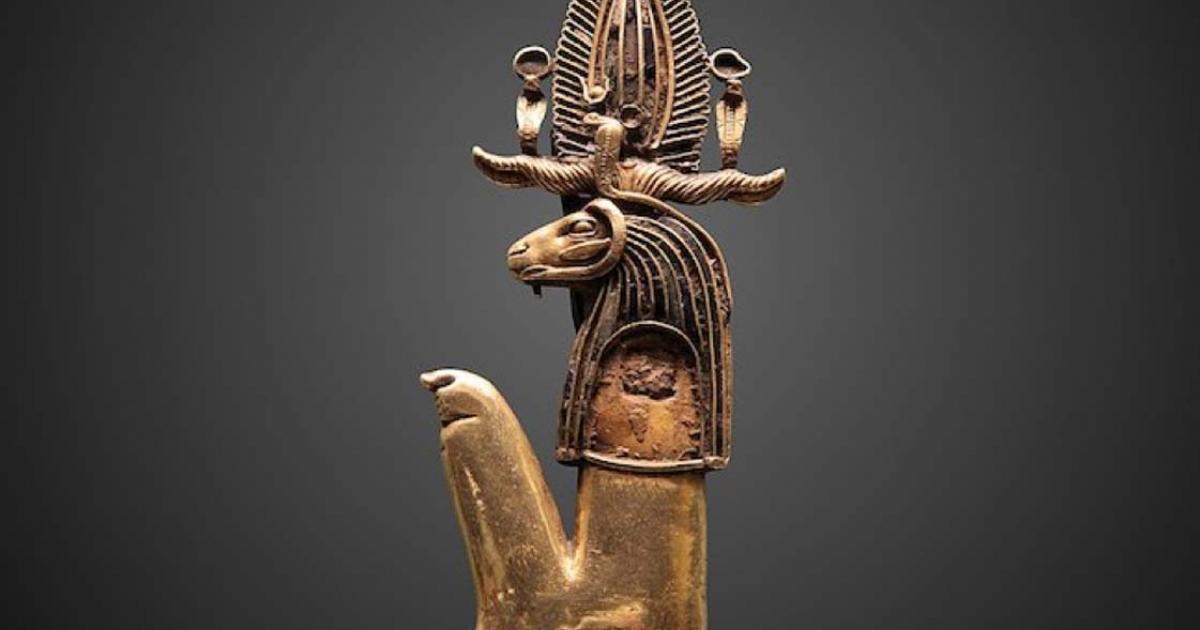
We all know that the wonders of the ancient Egyptian pantheon are many and so amazing – and the deities that lurk within that pantheon are almost impossible to count and mention. Many of these deities are popular even today – the chief gods that everyone knows Ra, Osiris, Thoth, Bast, Sekhmet, Sobek, and many, many more.
But some of these gods, even though they were very prominent in the ancient times, are hardly attested today. One such deity is Heryshaf, the ram headed creator god of fertility and power. Once an important god with his own cult centers and throngs of followers, Heryshaf is slightly forgotten today.
But as always, we are here to dust off the cobwebs from the history’s obscure niches, revealing the wonders of intriguing information that hides beneath. And today we are returning to the valley of the Nile and ancient Egypt – in search of the origins of Heryshaf!
The God of Fertility – Heryshaf Through Time
Throughout Egypt’s long history, and as the state and religion slightly evolved, so did Heryshaf. Over the many centuries, this deity had a few slight ‘adaptations’, but was mostly rooted in the original way in which it was presented. Heryshaf was depicted as a ram headed man – an anthropomorphic figure of a man in the usual pharaonic, dominant stance and wearing the royal dress (kilt).
His head is that of a ram, with the iconic splendid headdress which contains the elements of two most prominent gods of Egypt – Ra and Osiris. These elements are the ‘atef’ – crown of Osiris - and the sun disk of Ra. The adoption of these elements into the image of Heryshaf often led to the connection of these three deities, where Heryshaf was often compared to Ra or Osiris.
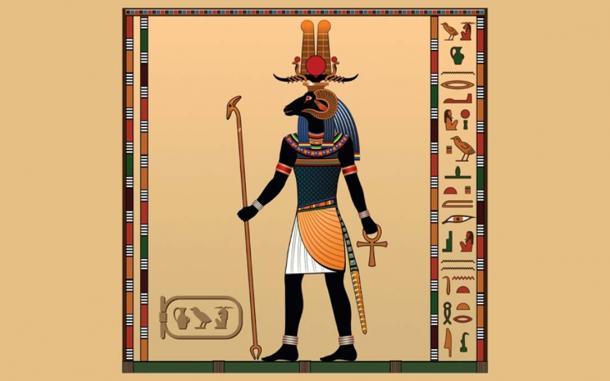
Egyptian god Heryshaf. Source: Vladimir Zadvinskii / Adobe Stock.
The ram headed deity Heryshaf was predominantly (if not exclusively) worshipped at his cult center at Henensuten – also known as Het-Henen-su - which later became known in Roman sources as Heracleopolis Magna. This city was the capital of the 20th nome in ancient Egypt and was a famous religious and cultural center throughout much of Egypt’s history.
His name also had several similar, but differently translatable variants – all depending on the hieroglyphic writing. He is attested as Heryshaf, Hershef, Hersheft. The Her-sheft version - ḥrj-šf.t - translates to “He Who is Over Strength”. This stems from the ending *sheft (šf.t) which denotes “strength, bravery, or power”. But his name in its usual form – Heri-sha-f or Her-she-f, means respectively, “He Who is On His Sand” and “He Who is On His Lake”.
The latter name is the most common form of Heryshaf – he was considered the god who was born from the primordial waters. This fact was further attested in the construction of his great temple at Henensuten, which sadly does not exist today – it was situated on the island surrounded by canals and waters. There, Heryshaf truly was on his lake.
When all things are considered, we can realize that Heryshaf was most likely a regional deity – i.e. a god that was worshiped solely at Heracleopolis Magna. Moreover, with that being said, it is likely that Heryshaf was in fact just a different aspect of the much more important and famed god Khnum – with whom he shares a lot of similarities. It could be that Heryshaf was a regional version of Khnum that was exclusive for Henensuten, aka Heracleopolis Magna.
- Egyptian Cat Goddess Bastet, Protector of the King
- Egyptian Demons and Magic: Exorcising Evil Spirits
- Archaeologists Discover a Resting Place for an Ancient Egyptian Sacred Boat
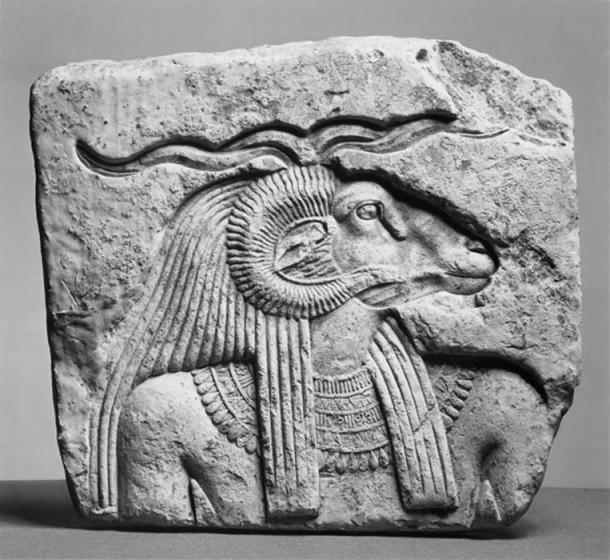
Heryshaf was similar to Khnum and may have been the same god. (Kaldair / Public Domain)
Khnum was a very important deity in ancient Egypt, considered as the creator of all life on the potter’s wheel. He was also one of the earliest Egyptian deities, connected to the very source of the Nile. Just like Heryshaf, he too was a ram headed man, adorned with ram’s horns and wearing the royal kilt and all the associated accessories. Rams were sacrificed to him as mummies.
Heryshaf - The Lord of Two Plains, Veiled in the Mystery of Egyptian Belief
There is also the very distinct possibility that Heryshaf was an offshoot of Khnem, and a deity in his own right. Surviving Egyptian inscriptions mention him as the “Ruler of the Riverbanks” and “The King of Two Lands”, the god whose right eye was the sun, and his left was the moon; the solar god who lit up the world, and whose soul was the light.
Heryshaf, much like Khnum, was born from the primordial waters and connected to them – i.e the Nile. One of his titles was the “Lord of Two Plains” which denoted the two level shores of the Nile. Moreover, he was called the “Uniter of the Two Plains” all of which is connected to the fertile flood cycle of the Nile. This is the reason for him often being depicted as seated on a nenufar – a water lily.
His name “He Who is on His Lake” could easily refer to the ancient Lake Moeris, which was once a sprawling freshwater lake and a very important source of water for the ancient Egyptians, attested as early as 3000 BC. Once more we are shown an important insight into the belief of ancient Egypt, and the connection of its people with the nature around them.
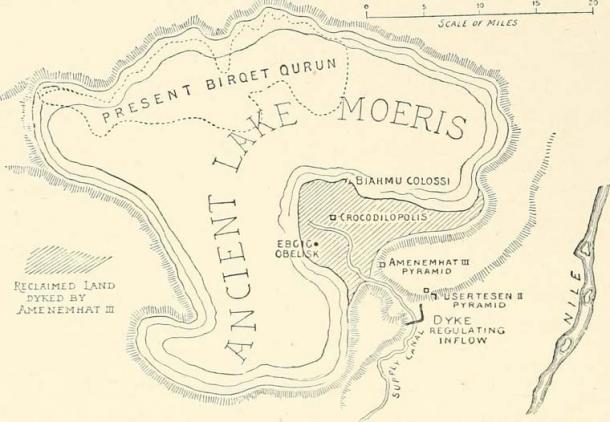
Map of ancient lake Moeris – Heryshaf’s name translates to “He Who is on His Lake”. (Wolfymoza / Public Domain)
Life was hard – and all that brought life was held in highest regard. And so, perhaps the great Lake Moeris was revered as the seat of Heryshaf – the great god of fertility.
The famed ancient Greek author Plutarch mentions Heryshaf in his writings, which he calls by his Greek name – Arsaphes. Plutarch also translates this word as “manliness”. This also ties in with the fact that ancient Egyptians often employed these slight “word plays” – bolstering the *shaf ending (“On His Lake”) with the word with a similar consonantal sound - *sheft (power, strength).
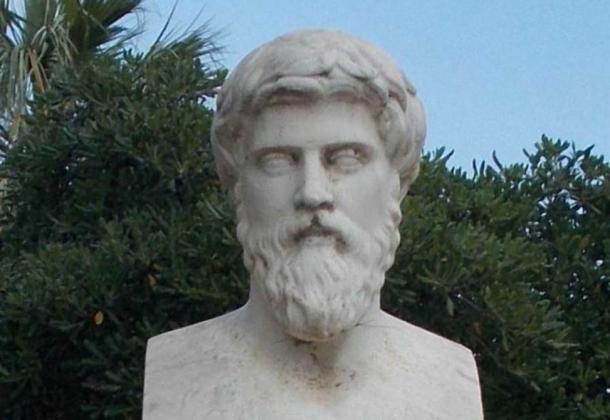
Plutarch wrote about Heryshaf as the Greek counterpart – Arsaphes. (Odyesses / CC BY-SA 3.0)
It is also quite likely that Heryshaf became Heracles in the Greek mythology, or merely connected with him. This also explains the Greek and Roman name for Heryshaf’s cult center, the town of Henensuten, which they named Heracleopolis Magna, most likely due to the connection of Heryshaf and Heracles.
This town, also known as Hnes, was at one time the capital of the northern Egypt, particularly at the years of the First Intermediate Period, which is the name for the years between the Pyramid Age and the Middle Kingdom. During this time Heryshaf really became prominent, most likely gaining most of his grandiose attributes which connected him with Ra and Osiris, and possibly Khnum. Moreover, he gained the epithet of being the “Ba” of Ra and Osiris – their soul.
As Henensuten, or Heracleopolis Magna, was his cult center throughout most of Egypt’s history, it was there that a huge temple stood in his honor. This temple to Heryshaf does not exist today and only scarce remains have been uncovered.
Perhaps the earliest forms of this temple date from the Middle Kingdom, from around 2000 BC. This temple was later enlarged and renewed under the rule of Ramesses II during the 19th dynasty. Due to the rising popularity of Heryshaf, and also to display his power, this ruler added monolithic, grandiose granite columns to the temple.
These had elaborate palm leaf decorations at the capitals which formed one large hypostyle hall. The descriptions are only pieced together from writings, mentions, and archaeological excavations.
It was also at this location that a magnificent gold statuette of Heryshaf was uncovered. This statue is elaborate and very rich, showing Heryshaf in his usual anthropomorphic form as a ram headed man. On the statuette is an inscription, bearing the name of Neferkare Peftjauawybast – a minor king of Henensuten, during the 3rd intermediate period.
At the time of his rule, Egypt was under attack from the Sudanese king Piye. This same Peftjauawybast sided with Piye and sent him great tributes from Henensuten – Heracleopolis – which, together with this solid gold statuette, tells us that the cult center of Heryshaf was sufficiently rich, and places this god among the very important ones, despite him being largely overshadowed today.

Golden statuette of Heryshaf with the name of Peftjauawybast, from Heracleopolis Magna. (Khruner / Public Domain)
Peftjauawybast’s Devotion to Heryshaf – A Stele With a Story!
One of the best and most detailed descriptions of Heryshaf comes from a very unlikely place, and far from Egypt. The description was discovered on a limestone funerary stele of an ancient Egyptian official – but oddly enough it was discovered in the remnants of Pompeii.
The story of this stele is very intriguing, as it was originally made and displayed for perhaps two centuries at the Heracleopolis Magna in Egypt. It was then at one point transported to Pompeii, where it stood as a part of the Temple of Isis.
This temple was created in answer to the rising cult of the Egyptian goddess Isis in Pompeii and was created in a dominant Greco-Roman fashion. The eventual sad fate of Pompeii is known to us all, and as the town was buried by volcanic ash so was this funerary Egyptian stele.
The stele was made for one Sematawytefnakht, a high Egyptian official who lived around 330 BC. This figure held a few high ranks at the time, including the high priest of Sekhmet, priest of Horus, royal treasurer, sole companion, haty-a and iry-pat.
This stele, which originally stood at the Temple of Heryshaf at Heracleopolis, provides us with an important insight into the late history of Egypt, and also the god Heryshaf. In the detailed hieroglyphic inscription, Sematawytefnakht passionately speaks of his great devotion to Heryshaf. He considers him to be his celestial patron, and in the text here describes this god in great detail.
He styles him as the “Lord of Gods”, “he whose right eye is the sun-disk, whose left eye is the moon, whose ba (soul) is the sunlight, from whose nostrils comes the north wind, to make live all things”.
Sematawytefnakht then narrates the partial story of his life in which Heryshaf greatly helped him. Sematawytefnakht claims that this god helped him when the Persian Achaemenid king Artaxerxes III conquered Egypt in 341 BC.
- Why No Nose? The Ancient Breath of Life and Remarkably Powerful ‘Living Statues’
- The Mortuary Temple of Hatshepsut at Deir el-Bahri
- The Magic of Heka: Ancient Egyptian Rituals That Have Crossed Cultures and Time

Sematawytefnakht praised and thanked Heryshaf for advising him in a dream, thus allowing him to live a fulfilled life. (Berthold Werner / CC BY-SA 3.0)
He became a sort of a collaborationist when he swore an oath to the Persian conqueror and went on to fight in the Battle of Issus in 333 BC on the side of the Achaemenids who fought against Alexander the Great. Sematawytefnakht claims in the inscription that the great god Heryshaf spoke to him in a dream, advising him to flee the battlefield and return to Henensuten, which this high official promptly did.
He survived and returned to Heracleopolis to serve Heryshaf in his great temple. And later, when Alexander conquered Egypt in 332 BC, he once more switched sides to serve him.
Sematawytefnakht ends his inscription stating that his “long lifetime of gladness” in such a chaotic age was all due to the divine grace of Heryshaf. He says to Heryshaf: “My heart sought justice in your temple night and day, and you rewarded me for it a million times.”
A great source for learning more about Heryshaf is certainly the collection of funerary inscriptions known as the Coffin Texts. These texts were the spells written on coffins and the sarcophagi of the deceased Egyptians. Some of them mention a more complex role of Heryshaf, and Hnes (Henensuten) as a very important site in Egypt.
One of these spells tells that the deceased person, after bathing in the “sacred lake”, is seeking the vision of great Heryshaf who is in his “pillared hall” (possibly the great temple). The spell names him as the “potent spirit who dwells in Hnes, on whose head are the plumes of Sopdu (the god of sky and the eastern borders) and the atef crowns”. Throughout these coffin spells, Heryshaf is often titled as the “Lord of Blood” and the “Flourishing of Slaughter”.
While these epithets could signify a sacrificial, or purifying role for the god, they could also be his connection with the demon-god Shezmu, a dualistic, savage deity who was considered as the one who butchered the deceased gods. He was a lion headed man, known as the “Lord of Blood”, “Great Slaughterer of the Gods”, and “He Who Dismembers Bodies”.
Heryshaf - He Whose Soul is the Sunlight
In Egypt’s history, the title of the high priest of Heryshaf was certainly a prestigious religious role and was held by male sons of pharaohs and other important figures. Some of them are named in the inscriptions from Heracleopolis, such as Ptahudjankhef, Pasenhor, Hemptah, and others.

Round-top stele with August as an Egyptian pharaoh making an offering to Egyptian gods Sobek-Re, Amon, and Heryshaf. (Jastrow / Public Domain)
There is no doubt that Heryshaf, He Who is on His Lake, the great Lord of Two Plains, was regarded as a very important and old deity in ancient Egypt, equal to the similar great ram headed deities such as Khnum. But history was not as kind to Heryshaf, as to the other prominent Egyptian gods – today he is largely obscure.
But history never sleeps when we’re around – and that’s why Heryshaf’s name is once again uttered.
Top image: Heryshaf depicted as a ram wearing symbolic headdress. (Rama / CC BY-SA 3.0)
References
Budge Wallis, E. 2013. The Gods of the Egyptians – Studies in Egyptian Mythology. Courier Corporation.
Butler, E. 2015. Herishef. Henadology.
Hart, G. 2005. The Routledge Dictionary of Egyptian Gods and Goddesses. Routledge.
Lichtheim, M. 2006. Ancient Egyptian Literature – The Late Period, Volume III. University of California Press.
Petrie Flinders, W. 2013. Ehnasya – The Labyrinth, Gerzeh, and Mazghuneh. Cambridge Library Collection.
Remler, P. 2010. Egyptian Mythology, A to Z. Chelsea House.



